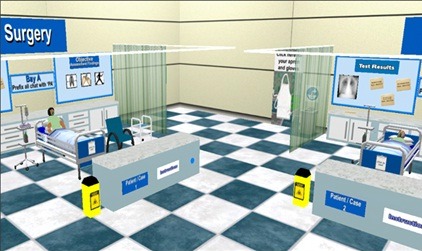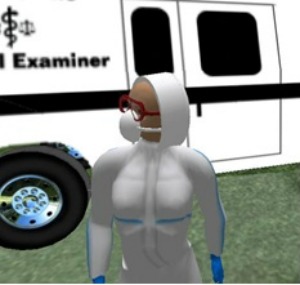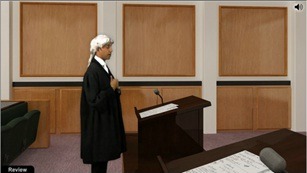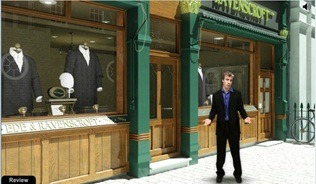From bioscience to law, Sarah Frame looks at how immersive technology helps learners.
Never before have we had access to such a wide variety of tools for learning and teaching as we do now. The advent of the internet, particularly Web 2.0 (the participative web) and social media technologies, combined with lowering of cost barriers, mass penetration of broadband and ownership of mobile devices has revolutionised the way in which we work, communicate and learn.
Virtual classrooms, books, audio, video, online courses, web resources such as blogs, wikis, podcasts, mobile apps, online communities, traditional classroom teaching, – something for everyone, whatever their preferred method of learning (or teaching).
However, most people agree that the best way to learn something new is by actually doing it. Sometimes of course that takes lots of practice, help from someone with experience, and repeated mistakes before we get it right. I only have to recall my early attempts at cookery to know how true that is . . .
In the world of education and training, there is a plethora of research and documentation expounding the benefits of experiential learning – learning by doing. But when is it possible or practical to create these immersive learning opportunities, what type of environment should we create and how do we use them effectively?
 "Using virtual world technologies certainly offers exciting potential for pedagogical innovation in e-learning, since it creates such a powerful sense of presence and the opportunity for social interaction."
"Using virtual world technologies certainly offers exciting potential for pedagogical innovation in e-learning, since it creates such a powerful sense of presence and the opportunity for social interaction."Until very recently, I was director of UELconnect at the University of East London (UEL), with responsibility for all the e-learning for both our on and off-campus students. In this article, I will share some of the experiences of using two different types of immersive environments at UEL – Second Life and Learnscapes.
Using virtual world technologies certainly offer exciting potential for pedagogical innovation in e-learning, since it creates such a powerful sense of presence and the opportunity for social interaction. However, it also presents significant challenges for teachers/trainers and, in many cases, also for learners.
Second Life
UEL has created Second Life (UEL SL) environments which offer a polyclinic for healthcare students, a crime scene house for forensic science students and a virtual laboratory for bioscience students. The polyclinic and crime scene house provide an opportunity for learners to experience situations which could not practically be replicated in real life.

In the polyclinic, students are presented with a range of patients in an outpatient clinic setting, and have the opportunity to talk to the patient, carry out examinations, read notes, consider test results and reach a diagnosis.

The crime scene house allows students to examine the various virtual crime scenes presented using real world methodologies and to learn the principles of forensic evidence gathering, such as how to collect, process, store and record biological samples that may be used as criminal evidence.
The virtual laboratory was initially developed to address the logistical problem of having high numbers of students needing to learn how to conduct complex experiments. Running those practical sessions in the university laboratories meant large class sizes, required a high staff presence and was very costly in terms of laboratory consumables.
In the university laboratory, students had a one-time-only chance to undertake the experiments, whereas a tangible benefit from using the UEL Second Life laboratory is that students can repeat the experiments, and receive feedback from the environment, as many times as they wish.
Feedback from users of the virtual laboratory has also been very good: "It was an inspiring module . . . it was a bit challenging initially understanding the tools and platform but the instructor assisted greatly." Some 92% said they would use Second Life again and many requested other experiments to be made available in the same way.
In a comparison of learners using the virtual laboratory with those using the traditional method, both sets of learners achieved the same outcomes when undertaking the practical test. However, the Second Life users asked far fewer questions and were noticeably more organised during the practical test, so it was felt that they had obtained a higher level of understanding as a result of using the UEL Second Life laboratory.
Although the feedback from students using Second Life was generally very positive, it was felt that many of the benefits of the virtual experiments could be derived alternatively through the use of Flash to create a simulation of the experiments. This could be achieved at a lower cost, and removed some of the barriers in terms of user skills required to access the experiments, and technical challenges experienced where students had difficulties accessing Second Life on home computers.
If then, you are considering the use of a 3D virtual world, it is worthwhile to think carefully as to whether the time and effort required for development and programming of a more complex environment is justified by the learning outcome required.
In situations such as the virtual health clinic or crime scene, where the recreation of the physical environment is crucial, then virtual world technologies are invaluable. If however, it is a task or activity, such as our experiments, that is required, then a more mainstream e-learning tool may be appropriate.
Learnscapes
A notable success at UEL in the use of immersive environments has been the joint development with Toolwire of a Learnscape. This immersive learning tool places the learner in a photorealistic three dimensional environment that combines video interaction and real world context, giving the learner the opportunity to explore the material they have learned in a personal manner, making it more relevant and enforcing key concepts.
Learnscapes allow learners an excellent opportunity to bring learning to life, and UEL developed a Learnscape to give law students the opportunity to practise legal skills. The learning process is enhanced as learners directly apply their learning to resolving a real life problem, in a virtual environment.
One of the key priorities for the project was to familiarise learners with the specific characteristics of the cultural and professional environment of the legal practitioner. The learnscape, called Plea in mitigation, replicates legal vocational practice, based in virtual locations, and incorporating occupational vocabulary, legal etiquette, courtroom scenarios and case research.

In essence, the learnscape allows the learner to try doing the job of a junior barrister making a plea in mitigation and along the way discovering all the pitfalls and issues they are likely to face in the real world. The learnscape provides the learner with the opportunity to learn by doing. Each scenario was carefully constructed to reflect the real life work processes which the learners would identify with, and with which they might expect to engage in their current or future practice.

The learner interacts with their more experienced colleague outside Fountain Court, a long established and substantial set of commercial barristers’ chambers, based in the Temple, London, or meets them at Ede & Ravenscourt, the well-known legal outfitters. Advice is given during a meeting with a barrister in the Wig and Pen Pub close to the Royal Courts of Justice and the sentencing scene is set in an actual court room.
These real life locations would otherwise be entirely unfamiliar to the learners and the sense of presence developed through interacting within the virtual environment would just not be achievable through conventional learning methods.
One of the most exciting outcomes of this project was the extremely positive feedback from the learners. When surveyed, 97% of respondents rated the learnscape as either very useful or extremely useful in preparing them for their assessment. The innovative approach was also appreciated with 94% indicating it was more effective than reading it in a book and 90% finding it more effective than learning the material by way of lecture, with 82% identifying its interactive nature as a key feature.
This was endorsed by comments such as:
- "I felt engaged as I could click and interact, rather than just sitting there reading or watching."
- "Don’t tell the lecturers, but we could have less lectures and more of this type of learning!"
- "Sometimes learning law is . . . well . . . a bit boring, this wasn’t!"
- "I didn’t feel I was learning law – I was doing it!"
- "I liked the characters they were real, I could just imagine meeting them."
The learnscape wasn’t merely an enjoyable addition to their studies though, as pass marks and pass rates both increased significantly, in comparison to previous year groups.
Conclusion
These projects using Second Life and learnscapes have undoubtedly enhanced the learning experience, and been well received by the users. Both tools provide a truly immersive environment, offering opportunities to the learner to learn by doing and practise the application of new skills in situations as close to the real world as possible.
Second Life does allow the learner to be almost entirely self-directed in their activities and responses, and so is ideal in situations as described above, where replicating the actual physical environment or practical techniques is crucial, for instance the crime scene.
The learnscape tool is useful for offering virtual internships. It provides an engaging and interactive way of introducing the learner to new types of situations, orientating them in new cultures or environments, and developing familiarity with procedures, vocabulary, and etiquette.
One of the greatest benefits from using immersive environments for learning is the potential to drive a higher level of performance within a shorter space of time. Consider the analogy of when, as an experienced driver, you borrow someone else’s car. No matter how good a driver you are, there is a period of adjustment whilst you familiarise yourself with driving a different car – controls in different places, and so on.
During this period of adjustment, your concentration and driving ability are affected to some degree – you are not as effective as you normally are. Similarly, performance is impacted whilst you adjust to working in an entirely unknown environment.
Immersive environments provide the opportunity to accelerate that process, and perform at a higher level more quickly. In our examples above, the law student has become accustomed to the physical and cultural peculiarities in our legal system, the healthcare student has developed confidence in working within a clinic and interacting with patients and the forensic investigator has practised the techniques of analyzing and operating at a crime scene.
They are therefore ahead of the learning curve in comparison to where they otherwise would be when encountering these environments in real life for the first time and so should be able to apply their knowledge more effectively.
The use of both these immersive learning environments has clearly demonstrated the way in which the learning experience and results have been enhanced. Together with user feedback, it should encourage us to use such tools to meet the demand from today’s learners for learning processes that are flexible, fast, fun and innovative and which genuinely prepare learners for real life applications.
Sarah Frame is director EMEA business development at Toolwire. You can learn more about Immersive Environments at the Learning Live conference where Sarah will lead a session on Using immersive environments and virtual worlds for learning impact. To find out more visit www.learning-live.com.
From bioscience to law, Sarah Frame looks at how immersive technology helps learners.
Never before have we had access to such a wide variety of tools for learning and teaching as we do now. The advent of the internet, particularly Web 2.0 (the participative web) and social media technologies, combined with lowering of cost barriers, mass penetration of broadband and ownership of mobile devices has revolutionised the way in which we work, communicate and learn.
Virtual classrooms, books, audio, video, online courses, web resources such as blogs, wikis, podcasts, mobile apps, online communities, traditional classroom teaching, – something for everyone, whatever their preferred method of learning (or teaching).
However, most people agree that the best way to learn something new is by actually doing it. Sometimes of course that takes lots of practice, help from someone with experience, and repeated mistakes before we get it right. I only have to recall my early attempts at cookery to know how true that is . . .
In the world of education and training, there is a plethora of research and documentation expounding the benefits of experiential learning - learning by doing. But when is it possible or practical to create these immersive learning opportunities, what type of environment should we create and how do we use them effectively?
 "Using virtual world technologies certainly offers exciting potential for pedagogical innovation in e-learning, since it creates such a powerful sense of presence and the opportunity for social interaction."
"Using virtual world technologies certainly offers exciting potential for pedagogical innovation in e-learning, since it creates such a powerful sense of presence and the opportunity for social interaction."Until very recently, I was director of UELconnect at the University of East London (UEL), with responsibility for all the e-learning for both our on and off-campus students. In this article, I will share some of the experiences of using two different types of immersive environments at UEL – Second Life and Learnscapes.
Using virtual world technologies certainly offer exciting potential for pedagogical innovation in e-learning, since it creates such a powerful sense of presence and the opportunity for social interaction. However, it also presents significant challenges for teachers/trainers and, in many cases, also for learners.
Second Life
UEL has created Second Life (UEL SL) environments which offer a polyclinic for healthcare students, a crime scene house for forensic science students and a virtual laboratory for bioscience students. The polyclinic and crime scene house provide an opportunity for learners to experience situations which could not practically be replicated in real life. 
In the polyclinic, students are presented with a range of patients in an outpatient clinic setting, and have the opportunity to talk to the patient, carry out examinations, read notes, consider test results and reach a diagnosis. 
The crime scene house allows students to examine the various virtual crime scenes presented using real world methodologies and to learn the principles of forensic evidence gathering, such as how to collect, process, store and record biological samples that may be used as criminal evidence.
The virtual laboratory was initially developed to address the logistical problem of having high numbers of students needing to learn how to conduct complex experiments. Running those practical sessions in the university laboratories meant large class sizes, required a high staff presence and was very costly in terms of laboratory consumables.
In the university laboratory, students had a one-time-only chance to undertake the experiments, whereas a tangible benefit from using the UEL Second Life laboratory is that students can repeat the experiments, and receive feedback from the environment, as many times as they wish.
Feedback from users of the virtual laboratory has also been very good: "It was an inspiring module . . . it was a bit challenging initially understanding the tools and platform but the instructor assisted greatly." Some 92% said they would use Second Life again and many requested other experiments to be made available in the same way.
In a comparison of learners using the virtual laboratory with those using the traditional method, both sets of learners achieved the same outcomes when undertaking the practical test. However, the Second Life users asked far fewer questions and were noticeably more organised during the practical test, so it was felt that they had obtained a higher level of understanding as a result of using the UEL Second Life laboratory.
Although the feedback from students using Second Life was generally very positive, it was felt that many of the benefits of the virtual experiments could be derived alternatively through the use of Flash to create a simulation of the experiments. This could be achieved at a lower cost, and removed some of the barriers in terms of user skills required to access the experiments, and technical challenges experienced where students had difficulties accessing Second Life on home computers.
If then, you are considering the use of a 3D virtual world, it is worthwhile to think carefully as to whether the time and effort required for development and programming of a more complex environment is justified by the learning outcome required.
In situations such as the virtual health clinic or crime scene, where the recreation of the physical environment is crucial, then virtual world technologies are invaluable. If however, it is a task or activity, such as our experiments, that is required, then a more mainstream e-learning tool may be appropriate.
Learnscapes
A notable success at UEL in the use of immersive environments has been the joint development with Toolwire of a Learnscape. This immersive learning tool places the learner in a photorealistic three dimensional environment that combines video interaction and real world context, giving the learner the opportunity to explore the material they have learned in a personal manner, making it more relevant and enforcing key concepts.
Learnscapes allow learners an excellent opportunity to bring learning to life, and UEL developed a Learnscape to give law students the opportunity to practise legal skills. The learning process is enhanced as learners directly apply their learning to resolving a real life problem, in a virtual environment.
One of the key priorities for the project was to familiarise learners with the specific characteristics of the cultural and professional environment of the legal practitioner. The learnscape, called Plea in mitigation, replicates legal vocational practice, based in virtual locations, and incorporating occupational vocabulary, legal etiquette, courtroom scenarios and case research.

In essence, the learnscape allows the learner to try doing the job of a junior barrister making a plea in mitigation and along the way discovering all the pitfalls and issues they are likely to face in the real world. The learnscape provides the learner with the opportunity to learn by doing. Each scenario was carefully constructed to reflect the real life work processes which the learners would identify with, and with which they might expect to engage in their current or future practice.

The learner interacts with their more experienced colleague outside Fountain Court, a long established and substantial set of commercial barristers' chambers, based in the Temple, London, or meets them at Ede & Ravenscourt, the well-known legal outfitters. Advice is given during a meeting with a barrister in the Wig and Pen Pub close to the Royal Courts of Justice and the sentencing scene is set in an actual court room.
These real life locations would otherwise be entirely unfamiliar to the learners and the sense of presence developed through interacting within the virtual environment would just not be achievable through conventional learning methods.
One of the most exciting outcomes of this project was the extremely positive feedback from the learners. When surveyed, 97% of respondents rated the learnscape as either very useful or extremely useful in preparing them for their assessment. The innovative approach was also appreciated with 94% indicating it was more effective than reading it in a book and 90% finding it more effective than learning the material by way of lecture, with 82% identifying its interactive nature as a key feature.
This was endorsed by comments such as:
- "I felt engaged as I could click and interact, rather than just sitting there reading or watching."
- "Don't tell the lecturers, but we could have less lectures and more of this type of learning!"
- "Sometimes learning law is . . . well . . . a bit boring, this wasn't!"
- "I didn't feel I was learning law - I was doing it!"
- "I liked the characters they were real, I could just imagine meeting them."
The learnscape wasn’t merely an enjoyable addition to their studies though, as pass marks and pass rates both increased significantly, in comparison to previous year groups.
Conclusion
These projects using Second Life and learnscapes have undoubtedly enhanced the learning experience, and been well received by the users. Both tools provide a truly immersive environment, offering opportunities to the learner to learn by doing and practise the application of new skills in situations as close to the real world as possible.
Second Life does allow the learner to be almost entirely self-directed in their activities and responses, and so is ideal in situations as described above, where replicating the actual physical environment or practical techniques is crucial, for instance the crime scene.
The learnscape tool is useful for offering virtual internships. It provides an engaging and interactive way of introducing the learner to new types of situations, orientating them in new cultures or environments, and developing familiarity with procedures, vocabulary, and etiquette.
One of the greatest benefits from using immersive environments for learning is the potential to drive a higher level of performance within a shorter space of time. Consider the analogy of when, as an experienced driver, you borrow someone else’s car. No matter how good a driver you are, there is a period of adjustment whilst you familiarise yourself with driving a different car - controls in different places, and so on.
During this period of adjustment, your concentration and driving ability are affected to some degree - you are not as effective as you normally are. Similarly, performance is impacted whilst you adjust to working in an entirely unknown environment.
Immersive environments provide the opportunity to accelerate that process, and perform at a higher level more quickly. In our examples above, the law student has become accustomed to the physical and cultural peculiarities in our legal system, the healthcare student has developed confidence in working within a clinic and interacting with patients and the forensic investigator has practised the techniques of analyzing and operating at a crime scene.
They are therefore ahead of the learning curve in comparison to where they otherwise would be when encountering these environments in real life for the first time and so should be able to apply their knowledge more effectively.
The use of both these immersive learning environments has clearly demonstrated the way in which the learning experience and results have been enhanced. Together with user feedback, it should encourage us to use such tools to meet the demand from today’s learners for learning processes that are flexible, fast, fun and innovative and which genuinely prepare learners for real life applications.
Sarah Frame is director EMEA business development at Toolwire. You can learn more about Immersive Environments at the Learning Live conference where Sarah will lead a session on Using immersive environments and virtual worlds for learning impact. To find out more visit www.learning-live.com.






